The design and ambiance of a restaurant play crucial roles in influencing customer satisfaction and retention. A well-designed space can create an inviting atmosphere that encourages diners to return, while poor design can lead to negative experiences that deter future visits. According to BinWise, about 60% of restaurants fail within the first year of operation, and 80% fail within the first five years, highlighting the importance of creating a memorable dining experience. In this article, we will explore how various aspects of restaurant design impact customer perceptions and loyalty.
The Importance of Aesthetics
Aesthetics are one of the most visible elements of restaurant design and can significantly affect customer impressions. The choice of color schemes, artwork, and décor contributes to the overall ambiance. For instance, warm colors such as reds and yellows can create a cozy, inviting environment, while cool colors like blues and greens may evoke feelings of tranquility. The décor, including wall art and furnishings, can also serve as a reflection of the restaurant’s brand identity and theme, making it more memorable.
In addition to visual appeal, aesthetics influence the emotional connection customers feel toward a restaurant. A well-curated space can generate positive feelings, encouraging customers to linger longer and, in turn, increasing their likelihood of ordering more. However, it’s essential to remember that aesthetics must be complemented by functionality; an eye-catching design that hampers service or comfort will ultimately backfire. For example, poorly placed furniture can obstruct pathways, leading to a frustrating experience.

Functionality and Layout
While aesthetics draw customers in, the functionality and layout of a restaurant are crucial for ensuring their comfort and satisfaction during their visit. A well-planned layout can optimize customer flow, making it easier for diners to navigate the space and for staff to serve them efficiently. Key considerations include seating arrangements, the proximity of the kitchen to the dining area, and the overall traffic flow within the restaurant.
Seating arrangements can greatly impact group dynamics. For instance, booths can provide a sense of privacy for couples, while larger tables are suitable for family gatherings. Additionally, ensuring that the layout accommodates accessibility for all patrons is not only a legal requirement but also an essential aspect of customer satisfaction. Designing spaces that are accessible to individuals with disabilities demonstrates inclusivity, fostering goodwill and loyalty among customers.
Moreover, the layout must be functional for staff as well. A well-designed kitchen that is efficiently located can lead to quicker service, enhancing the overall dining experience. Structural considerations, like the roof, also play a role in functionality. The life expectancy of a roof depends on the type of material used, with TPO roofs lasting 18 to 20 years, EPDM roofs from 15 to 18 years, and PVC roofs up to 30 years. Choosing the right roofing material is essential not just for the longevity of the restaurant but also for maintaining a comfortable dining environment, as leaks or structural issues can lead to customer dissatisfaction.

The Role of Cleanliness
Cleanliness is an often-overlooked aspect of restaurant design that can have a significant impact on customer satisfaction. According to Business Wire, 93% of people would avoid a business in the future if they encountered dirty restrooms. This statistic underscores the importance of maintaining high standards of cleanliness in all areas of a restaurant, particularly in visible spaces like restrooms.
Designing for cleanliness can include the use of durable materials that are easy to clean, strategic layouts that minimize clutter, and adequate facilities for staff to maintain hygiene. For instance, choosing flooring that can withstand spills and is easy to mop can keep the environment looking pristine. Additionally, having a well-located restroom that is easy to access but discreetly placed can enhance the overall customer experience.
The design of a restaurant is a multifaceted aspect that significantly influences customer satisfaction and retention. By paying attention to aesthetics, functionality, cleanliness, and technology integration, restaurant owners can create an environment that attracts and retains customers. Investing in a well-designed restaurant is not merely a matter of aesthetics; it’s a critical component of building a loyal customer base and ensuring long-term success in a competitive industry.






